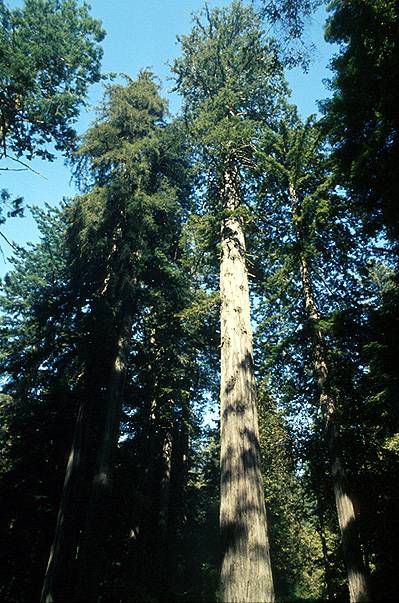Coastal redwood
Coastal Redwood (Sequoia sempervirens), also known as the California redwood, is an evergreen, long-lived, monoecious tree residing primarily in the coastal regions of Northern California and the southwestern corner of Oregon within the United States. It is famous for being among the tallest trees in the world, a characteristic that has garnered it significant attention both scientifically and from the general public. This article aims to provide a comprehensive overview of the Coastal Redwood, including its habitat, characteristics, ecological significance, and conservation efforts.
Habitat and Distribution[edit | edit source]
The Coastal Redwood thrives in the moist, fog-laden environment of the Pacific Coast. This unique climate provides the necessary moisture for the redwood's growth, supplementing the region's limited rainfall. The fog contributes significantly to the ecosystem by reducing evapotranspiration and aiding in the conservation of water. The natural range of Sequoia sempervirens extends from the southwestern corner of Oregon down through California, reaching as far south as the Big Sur region.
Characteristics[edit | edit source]
Sequoia sempervirens can reach heights of over 300 feet (91 meters), with the tallest known specimen, named Hyperion, standing at approximately 379.7 feet (115.7 meters). The diameter of these trees can exceed 20 feet (6 meters), with the bark itself being quite thick, fibrous, and deeply furrowed. This bark contributes to the tree's resistance to fire, a common occurrence in its natural habitat. The leaves are needle-like, with a bright green coloration on the top and two blue-white stomatal bands on the underside. Coastal Redwoods are known for their longevity, with some specimens being over 2,000 years old.
Ecological Significance[edit | edit source]
The Coastal Redwood plays a crucial role in its ecosystem. It provides habitat for a variety of species, including the Northern Spotted Owl and the Marbled Murrelet, both of which are listed as threatened. The dense canopies and thick underbrush create a unique microenvironment that supports diverse plant and animal life. Additionally, the redwoods play a significant role in carbon sequestration, helping to mitigate the effects of climate change.
Conservation[edit | edit source]
Despite their resilience, Coastal Redwoods face several threats, including logging, urban development, and climate change. Conservation efforts have been underway for decades, with organizations such as Save the Redwoods League working to protect these majestic trees through land acquisition, restoration projects, and advocacy. The establishment of Redwood National and State Parks has also been critical in preserving significant tracts of old-growth forests.
Cultural Significance[edit | edit source]
The Coastal Redwood has held immense cultural significance for indigenous peoples of the region, who utilized the tree's wood for building materials and its bark for various purposes. Today, the redwoods continue to inspire awe and appreciation, drawing visitors from around the world to witness their grandeur firsthand.
Search WikiMD
Ad.Tired of being Overweight? Try W8MD's physician weight loss program.
Semaglutide (Ozempic / Wegovy and Tirzepatide (Mounjaro / Zepbound) available.
Advertise on WikiMD
|
WikiMD's Wellness Encyclopedia |
| Let Food Be Thy Medicine Medicine Thy Food - Hippocrates |
Translate this page: - East Asian
中文,
日本,
한국어,
South Asian
हिन्दी,
தமிழ்,
తెలుగు,
Urdu,
ಕನ್ನಡ,
Southeast Asian
Indonesian,
Vietnamese,
Thai,
မြန်မာဘာသာ,
বাংলা
European
español,
Deutsch,
français,
Greek,
português do Brasil,
polski,
română,
русский,
Nederlands,
norsk,
svenska,
suomi,
Italian
Middle Eastern & African
عربى,
Turkish,
Persian,
Hebrew,
Afrikaans,
isiZulu,
Kiswahili,
Other
Bulgarian,
Hungarian,
Czech,
Swedish,
മലയാളം,
मराठी,
ਪੰਜਾਬੀ,
ગુજરાતી,
Portuguese,
Ukrainian
Medical Disclaimer: WikiMD is not a substitute for professional medical advice. The information on WikiMD is provided as an information resource only, may be incorrect, outdated or misleading, and is not to be used or relied on for any diagnostic or treatment purposes. Please consult your health care provider before making any healthcare decisions or for guidance about a specific medical condition. WikiMD expressly disclaims responsibility, and shall have no liability, for any damages, loss, injury, or liability whatsoever suffered as a result of your reliance on the information contained in this site. By visiting this site you agree to the foregoing terms and conditions, which may from time to time be changed or supplemented by WikiMD. If you do not agree to the foregoing terms and conditions, you should not enter or use this site. See full disclaimer.
Credits:Most images are courtesy of Wikimedia commons, and templates Wikipedia, licensed under CC BY SA or similar.
Contributors: Prab R. Tumpati, MD

